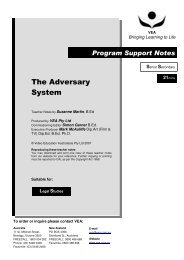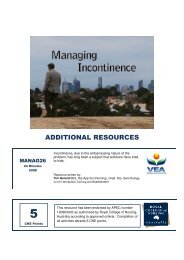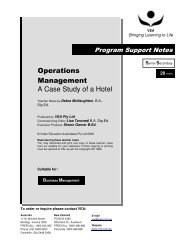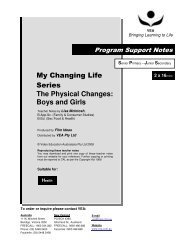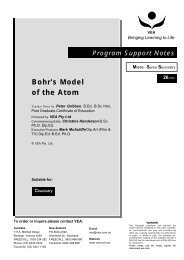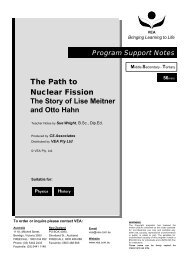guess who's coming to dinner in the new millenium - fibre - VEA
guess who's coming to dinner in the new millenium - fibre - VEA
guess who's coming to dinner in the new millenium - fibre - VEA
Create successful ePaper yourself
Turn your PDF publications into a flip-book with our unique Google optimized e-Paper software.
SYNOPSIS<br />
GUESS WHO’S COMING TO DINNER IN THE NEW<br />
MILLENIUM? - FIBRE<br />
This video demonstrates and expla<strong>in</strong>s:<br />
• Def<strong>in</strong>ition of dietary <strong>fibre</strong><br />
• Health risks from a low <strong>fibre</strong> diet<br />
• Structure and sources of <strong>fibre</strong><br />
• Recommended daily dietary requirements of <strong>fibre</strong><br />
• Fibre and <strong>the</strong> digestive system<br />
• How dietary <strong>fibre</strong> m<strong>in</strong>imizes risk of certa<strong>in</strong> diseases<br />
• How <strong>to</strong> <strong>in</strong>crease <strong>fibre</strong> <strong>in</strong> <strong>the</strong> diet.<br />
SUGGESTED USES OF THE VIDEO<br />
• Health and Physical Education classes<br />
• Nutrition, Health and Human Development classes Food Technology classes where<br />
plann<strong>in</strong>g healthy diets is required<br />
• Science classes where <strong>the</strong> <strong>to</strong>pics of digestion and function of plant products <strong>in</strong> <strong>the</strong> diet<br />
are studied.<br />
SUGGESTED PRE-VIDEO DISCUSSION<br />
• The video will show us how a substance we eat <strong>in</strong> plant products and don’t really digest,<br />
helps us <strong>to</strong> rema<strong>in</strong> healthy and lessen <strong>the</strong> risk of some unpleasant diseases.<br />
• By watch<strong>in</strong>g Mischa, a young guy, learn<strong>in</strong>g about this substance called dietary <strong>fibre</strong>, you<br />
should be able <strong>to</strong> get a good idea about why it is important <strong>to</strong> eat enough <strong>fibre</strong>.<br />
• The video tells how <strong>to</strong> <strong>in</strong>crease <strong>the</strong> amount of faeces we do daily and thus improve our<br />
chances of good health.<br />
DETAILED VIDEO CONTENT<br />
Mischa is shown eat<strong>in</strong>g white bread while a voice over expla<strong>in</strong>s that <strong>fibre</strong> used <strong>to</strong> be called<br />
roughage and how it protects us from <strong>the</strong> “diseases of affluence” such as colon cancer,<br />
coronary heart disease, diabetes, diverticulitis, high cholesterol and obesity. It also helps<br />
control diabetes and relieves constipation.<br />
WHAT IS FIBRE? Fibre is <strong>the</strong> cell walls of plants, <strong>the</strong> sk<strong>in</strong> and flesh of fruit and vegetables<br />
and <strong>the</strong> outer cover<strong>in</strong>g of gra<strong>in</strong>s such as wheat and rice.<br />
The <strong>fibre</strong> content of a lettuce leaf and cabbage leaf is compared – <strong>the</strong> easily <strong>to</strong>rn lettuce leaf<br />
conta<strong>in</strong>s less <strong>fibre</strong> than <strong>the</strong> <strong>to</strong>ugher cabbage leaf.<br />
Strong fibrous cell walls prevent plants be<strong>in</strong>g liquids, not<strong>in</strong>g that milk has approximately about<br />
90% water which is similar <strong>to</strong> <strong>the</strong> water content of many fruit and vegetables. If someone<br />
chews/eats fruit it takes <strong>the</strong>m longer than dr<strong>in</strong>k<strong>in</strong>g a fluid, consequently it is harder <strong>to</strong> over<br />
consume solid foods conta<strong>in</strong><strong>in</strong>g dietary <strong>fibre</strong>.<br />
Carbohydrate classification is described as<br />
• Available e.g. starches and sugars which are digested <strong>in</strong> <strong>the</strong> s<strong>to</strong>mach and small <strong>in</strong>test<strong>in</strong>e;<br />
• Unavailable e.g. cellulose, hemicelluloses and pect<strong>in</strong> which pass through <strong>the</strong> s<strong>to</strong>mach,<br />
undigested <strong>to</strong> <strong>the</strong> colon and are <strong>the</strong> most important types of <strong>fibre</strong>.<br />
There are also <strong>the</strong> non-carbohydrate types of <strong>fibre</strong> called Lign<strong>in</strong>, gums and mucilages.<br />
Cellulose makes up <strong>the</strong> structure of plant cell walls and is found <strong>in</strong> all plant foods e.g.<br />
wholegra<strong>in</strong>s, brans, wholemeal bread, dried fruit and <strong>the</strong> cabbage family,<br />
Hemicelluloses are found <strong>in</strong> plant tissues; especially cereal husks/bran and <strong>the</strong>y have a high<br />
water-b<strong>in</strong>d<strong>in</strong>g capacity.<br />
Pect<strong>in</strong> is found <strong>in</strong> fruit especially apples and citrus fruit and it helps slow down nutrient<br />
absorption <strong>in</strong> <strong>the</strong> <strong>in</strong>test<strong>in</strong>e.<br />
Lign<strong>in</strong> is <strong>the</strong> only component of <strong>fibre</strong> that escapes digestion, even by bowel bacteria and is<br />
found <strong>in</strong> cereals and old woody vegetables.<br />
WHAT DOES FIBRE DO? In our mouth, saliva <strong>in</strong>creases food’s digestibility. Prote<strong>in</strong>,<br />
carbohydrate, m<strong>in</strong>erals and vitam<strong>in</strong>s are absorbed from <strong>the</strong> s<strong>to</strong>mach <strong>to</strong> <strong>the</strong> small <strong>in</strong>test<strong>in</strong>e,<br />
2



